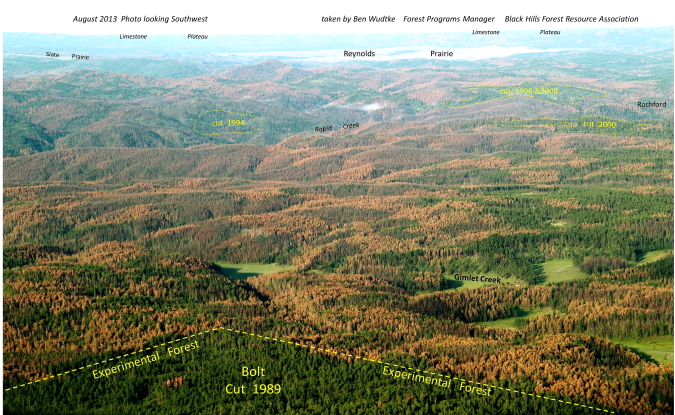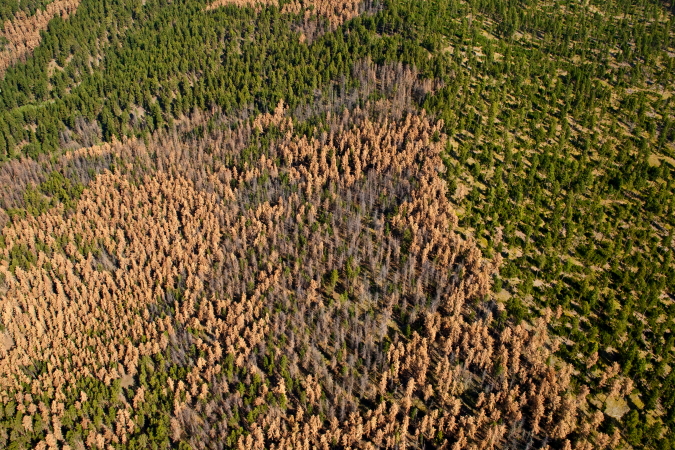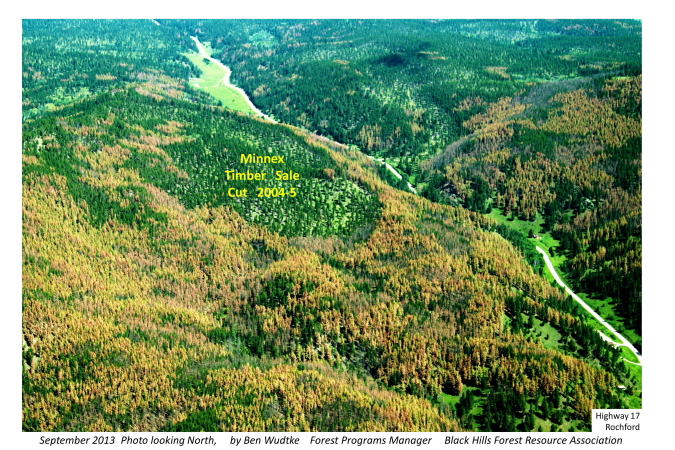Myths and Facts about Forestry
The issues that surround forestry and management are contentious and complicated to begin-with. Transpose this situation onto the management of public forests, such as the Black Hills National Forest, and you’ve got controversy coming out your ears. Regrettably, some people and organizations who participate in the debate about forest management have elected to use half-truth and, in some instances, complete myth in their attempts to influence public perceptions about forestry and the forest products industry. We’ll tell it to you straight, here: our treatise on some of the myths and facts about forestry.

Myth 1: Forestry on National Forests amounts to a subsidy of the forest products industry.
Facts: Ask anyone who works for a company that purchases federal timber, and this statement incites out-loud laughter. Firstly, any and all timber the Forest Service contemplates selling is appraised by the agency to establish its fair market value. This ensures that the federal government (and, you, the taxpayer) gets the same compensation for what it sells as would any other seller at the going market rate.
Second, when timber is offered for sale, a competitive auction system is used to award the purchase; that is, prospective buyers (forest products companies, independent logging contractors, etc.) bid against each other based on their estimation of the timber’s value, and the sale is awarded to the one who issues the highest bid above the minimum. The minimum, of course, is pre-established through the aforementioned appraisal system.
Third, the Forest Service isn’t just proposing to harvest timber for the sake of feeding sawmills. Part of the legally recognized goal of harvesting timber from national forests is to provide timber to the nation’s overall economy and to help satisfy the country’s need for wood products in our everyday lives. Part-two of the equation is that many other land stewardship goals – such as habitat management, recreational improvements, road maintenance, forest health, and wildfire protection – are accomplished through the sale of timber on national forests. In other words, the sale of forest products is a means to accomplish several different objectives, and is also a means that is able to generate revenue along the way.
Lastly, the legal management mandate under which the Forest Service operates is ‘multiple-use’; this means that national forests are to provide a balanced suite of beneficial uses to the public. Forests provide all kinds of benefits to all kinds of people – some are tangible economic benefits, some are socially and emotionally derived benefits, and some are a combination of the two. So, national forests were designed to provide service outputs like forest products and forage for livestock grazing alongside providing opportunities for hiking, fishing, camping, hunting, and other forms of recreation, all in an environmentally sensitive manner that conserves these areas for the enjoyment of future generations. In contrast, many millions of acres of other federally-administered lands (such as National Parks, National Monuments, and the Wilderness System) are set aside as no-use areas where human interference is minimal and nature is left to its own devices. The mission of the National Forest System, however, is to sustain “working landscapes.”
Most often the ‘subsidy’ argument is based upon the fact that the price the Forest Service receives for timber is insufficient to balance out all the costs incurred by the government during environmental review and documentation, sale preparation, and administration. Well, you’ll notice that one of the things that went conspicuously unmentioned in the multiple-use discussion above was ‘maximizing’ dollar returns. Making the most money possible is not and has never been a mission of the Forest Service. Moreover, many of the administrative costs associated with Forest Service timber preparation aren’t what could be considered “market forces.” These include lengthy and over-lapping procedural and environmental documentation requirements, not the least of which are administrative appeals filed by the very groups making these subsidy allegations. Furthermore, national forests are not managed to maximize timber growth or timber quality, which means that a good portion of the forest products harvested from these lands are of relatively low commercial value. These are conscious ecological trade-offs, for which there are also conscious economic trade-offs – in this light the subsidy argument just doesn’t pass the giggle test.
Myth 2: The ‘big timber companies’ just run amok in the national forest and willy-nilly, as they please, cut down all the biggest, best and oldest trees.
Facts: This one falls into the “maliciously false” category. Purchasers of national forest timber have no say whatsoever – none, nada, zip, zilch – in which trees are cut and which remain during a given timber sale. Long before a timber sale is ever bid upon by a purchaser, the Forest Service identifies an area in need of management, evaluates its environmental concerns, and decides what forestry practices ought to be applied in order to meet the management objectives. After the competitive bidding process earlier described, the successful bidder signs a contract with the Forest Service to perform the needed management activities; this is no different from any other contract, and the penalties for breaching the contract are severe, including being de-barred from ever bidding on another Forest Service timber sale. The average Forest Service contract is 200 pages long, including every last detail down to how and where roads are to be constructed, what kind of logging equipment should be used and under what conditions (such as prohibiting equipment use during times the soil is excessively wet), how purchasers should take care of leftover limbs and brush, and on, and on.
Now is as appropriate a time as any to talk about which trees get cut and which don’t as it pertains to “old-growth” or other big trees. On the Black Hills National Forest, all sizes of trees are managed – big and small, old and young. As was discussed in our Forestry 101 article, ponderosa pine forests in the Black Hills are managed using a “shelterwood/seed-tree” system. This means that we begin with a young, crowded stand of trees, thin it out and wait for it to grow, then thin it again, and sometimes even a third time. Thinnings effectively redistribute the growth resources of the forest – the light, water, and soil nutrients trees need to grow – onto fewer trees each time, allowing them to grow up fast and healthy. After the second or third thinning, the cycle of the trees’ life begins anew; the forest is open enough that seedlings begin to grow up underneath the ‘shelter’ of large mature trees. Once seedlings have a firm hold, we harvest some of the remaining mature trees and the cycle of thinning begins again. So, it’s absolutely correct to say we harvest big trees… But most of the time, it’s only after we’ve first grown them to be that way by harvesting a whole lot of little ones.
In general, the Forest Service’s goal is to perform this system across the Black Hills, such that a diversity of forest conditions (old, big, young, small, dense, open-grown, etc.) exists throughout the forest. They have done this with success; Forest Inventory and Analysis data from 1999 show that about 31 percent of ponderosa pine forests in the Black Hills are 100 years old or more, another 25 percent are in the 80 to 100 year-old range, with 28 percent in the under-80 category (the remaining 16 percent is made up of tree species other than ponderosa pine). Now, keep in mind that the Forest Service has, with the help of the forest products industry, been at the job of managing the Black Hills for over 100 years. Today – largely as a product of all that management – we still have a green forest that contains about three times as much timber as it did in the late 1800s. There is a library of research about the Black Hills going back more than 100 years, all the way to the first ever timber sale on federal land, that shows the tremendous resiliency of this forest and the propensity for rapid growth through management. Those who would paint national forest management in an unsustainable, irresponsible, or slave-to-the-industry light aren’t telling you the whole story.
Myth 3: All the so-called ‘forest health’ and wildfire problems on national forests are caused by irresponsible logging practices that cut all the biggest fire-resistant trees.
Facts: This is a little redundant, given our discussion about ‘Myth 2’, but is worth addressing. Pictures are really worth a thousand words, here. In 1874, Gen. George Armstrong Custer led an expedition to the Black Hills. Along for the ride was a photographer named W.H. Illingworth, who documented their journey extensively. Recently, it was realized that Illingworth’s photos represent a great basis of comparison for the 100 years of management that have gone on here in the Black Hills. Present-day photographer Paul Horsted recently duplicated Illingworth’s photo points to demonstrate this century of change, and published a book called Exploring with Custer. Several of his comparison photo sets can be viewed at Mr. Horsted’s web site – have a look! Pretty dramatic, huh? Most historic accounts note the scarceness of “old forest” in the Black Hills; one in particular estimated forty percent of the area was meadow, another forty percent was small trees ‘unfit for the sawmill’, ten percent was damaged by weather or wildfire, and only the last ten percent was ‘good lumber’.
Myth 4: The delicate balance of forests is fragile and we as humans must not meddle in it.
Facts: This statement is pretty loaded and emotionally charged. It implies, rightfully, that forests are something special and we ought to do our best to care for them. However, science tells us the statement above contains two purely false assertions; can you guess what they are? The first is that anything resembling a “delicate balance” has ever existed in nature, and the second is that forests are “fragile.”
The idea of a ‘delicate balance’ came from scientists who thought, during the early 1970’s, that forests were always growing toward a mature state which, once reached, would exist in perpetuity. This concept has been called a number of things – stable-state, climax forest, old-growth – but science has since discovered that the idea of forests staying essentially the same for long periods of time is simply impossible. Think about it: were the ‘delicate balance’ theory of stable-state forests true, we would only have but a few tree species on earth. Like many common house and garden plants, different tree species are adapted to different light, moisture, soil, and climate conditions. In the idyllic stable-state, old-growth forest, one does not find fast-growing, short-lived tree species that need lots of sunlight to survive. If these forest conditions truly made up 100 percent of forested landscapes in the millennia before humans arrived, tree species dependent on full sunlight would be extinct! The reason we are blessed with such a diversity of tree species, then, is because forests are in a constant state of change – that is, constantly out of balance.
The idea of ‘fragile’ forests is equally nonsensical. Nature is chaotic and ever-changing, as we’ve discussed. Therefore, the forests subject to nature’s forces must be resilient and responsive. To understand this concept, it’s useful to think about the ‘forces of nature’ that shape forests; those being, wildfires, tornadoes, hurricanes, volcanic eruptions, floods, lightning, temperature and climate extremes, wind, snow, and ice storms, diseases, and insects. Hardly subtle means, wouldn’t you say? If forests were unable to resist or recover from such cataclysmic events, we simply wouldn’t have forests. In response to this fact of life, forest systems have evolved to reproduce themselves abundantly, to grow in a manner that helps them guard against the continual onslaught of nature’s disturbances – that is, forests are tough cookies.
Mountain Pine Beetle
There is nothing to worry about; our winter will kill the beetles.Winter temperatures in the Black Hills, while often blustery, are rarely cold enough to result in significant beetle mortality. To kill beetles, we would need to experience sustained temperatures below -40 F during midwinter or temperatures below 0 F in the fall or spring. We did not experience these temperatures this fall, nor are we likely to see them this spring. Rarely can we rely on winter to solve a beetle problem.
The beetles will not be a problem; the summer rains (or woodpeckers) will kill them. Rain does not stop the beetles from flying. We would need something of Biblical proportions to have any influence on flight behavior. Woodpeckers as well as a number of other bird and insect species feed on mountain pine beetles. Unfortunately, once the beetle populations start increasing rapidly, their natural enemies can’t eat them fast enough to have much of an effect.
Well, if the beetles are a problem, it is because of logging. In fact, silvicultural control measures are the most effective means of managing the mountain pine beetle; by this we mean regulating stand density. The beetle tends to prefer trees in dense stands. These trees are usually weaker due to the intense competition for light, moisture and nutrients, and so are easier to attack and kill. Beetle behavior is influenced by stand density in another way – it likes cooler, more shaded environments found in very dense forest. If a stand is held below a certain density (identified through research as around 80 square feet of basal are per acre), the beetle is rarely a problem. Below are two images illustrating the resistance of a thinned area against severe beetle infestation in surrounding dense stands.
 |
 |
But the increase in smaller diameter trees – since they cut all the big ones – is increasing the beetle population, so logging is the problem. No, while it is true there has been an increase in smaller diameter trees (i.e., less than 8 inches in diameter) from 120 years ago and a decrease in larger trees (i.e., those over 16 inches in diameter), the beetle tends to attack large diameter trees, not small ones. Stands with an average tree diameter of more than 10 inches and extremely dense stocking (> 150 square feet per acre) are at highest risk of attack. As the average diameter decreases and density decreases, the potential risk also decreases. It is the bigger trees, not the smaller ones that are vulnerable to attack.
The beetles are a natural part of the Black Hills, there is nothing we can do about it. Again, this one is half-correct. The beetle is native to the Black Hills and probably has been here as long as there have been pines. Outbreaks have been reported in the Black Hills many times during the past one hundred years. Perhaps the most famous was the outbreak that occurred about 100 years ago. That one resulted in approximately 150 to 200 square miles of beetle-killed forest. While none of the outbreaks that have followed have even come close to the same losses, they can still result in significant tree losses. The statement, “we cannot do anything about it”, is dead wrong. No, we can’t eliminate the beetle, but we can manage it. Maintaining healthy stands is the best, but not the only means of managing the beetle. As an example, we can also employ such tactics as using the beetles’ own complex chemical communication system against them through pheromone trapping.
